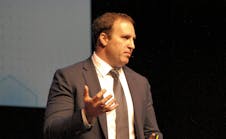The future of automation remains human at its core
The future of automation is developing at a faster pace than at any other time in the process control industry. While the prospect of more autonomous operations can seem as intimidating as it is exciting, Jim Masso, president and CEO, Honeywell Process Solutions, said that while the reality is that a change toward autonomy is happening, the most essential element of that change management for plants and facilities remains people.
“A lot of times when we talk about the future of automation, we talk about a top-down approach, but with deep domain depth, your people drive these changes,” Masso told an audience of Honeywell’s users and partners during the kick-off keynote presentation of the Honeywell Users Group EMEA meeting in The Hague, Netherlands, on November 11.
Masso, who was named president and CEO in July, compared the development of industrial automation to another game-changing development 50 years ago—the distributed control system (DCS). As Honeywell celebrated the golden anniversary of the DCS, Masso and many of the executives on hand for the session pointed out that just as the DCS succeeded in improving connectivity and efficiency over the past half century, the trajectory of autonomous control systems is following a similar developmental path, only faster.
“It wasn’t about reducing the number of people at a facility or a plant, or about reducing costs,” Masso said of the DCS. Rather, he pointed out that it was always about taking advantage of the power of connectivity. Honeywell aims to lead the charge when it comes to creating more precise outcomes that leverage deep domain depth. The result, Masso said, is more precise, deterministic outcomes for facilities.
Forging intelligent operations
Honeywell Forge has been a familiar tool for users at the center of the charge to autonomous operations. Forge is an IoT platform delivering AI-enabled applications and services for intelligent, efficient and more secure operations.
“We generate a tremendous amount of data,” Masso said, “but I think more importantly, we have a vehicle by which to drive that ecosystem.”
He also discussed the importance of the company’s Digital Cognition offering as automation quickly develops, and instruments and systems become smarter and more connected. He touted the concept of see, think, act and learn as a basis for driving more deterministic outcomes.
Masso added that automation can be simple when it is thought of as assets that are more connected and aided by software to drive better and more optimal outcomes. Those outcomes happen across a variety of areas, from better cybersecurity capabilities to enhanced workforce capabilities—augmenting less experienced operators while driving better insights for equipment reliability.
Masso also announced Honeywell’s newest enterprise services offering, Honeywell AutonomyX, which made its debut at the user conference. The mission of Honeywell AutonomyX is to empower industrial leaders with end-to-end enterprise transformation by integrating strategy, technology, and execution through measurable business outcomes. The services align C-suite vision with operational KPIs through tailored consulting engagements, while leveraging Honeywell’s deep domain expertise across AI/autonomous, cybersecurity, energy advisory and digital reliability domains.
Focus on people
Masso said AI can only take industrial automation so far down the road, but it is human thought that can make automation more effective. People will also be at the center of the automation of systems. “We focus a lot on the people element of adopting this change in automation and what I've started to see more and more is actual operators at the plant getting excited about new capabilities,” Masso said.
He cited a large chemical refinery that initially adopted asset performance management based on the Forge platform to drive maintenance decisions. “They were able to show me real data on their savings,” he recalled.
The facility was presented with several AI-enabled concepts, but they still require deep expertise to drive automated processes to produce better and more consistent outcomes.
The facility implemented an autonomous controller, which Masso said offered a profound example of success in automation. “They had operators with relatively little experience telling me how this system was implemented, how they were excited.” he said. “They told me how it made it possible for them to transfer work from one site to another.”
Before leaving the stage, Masso told HUG attendees that over the following three days they’d see a range of innovative technologies that have been implemented across life sciences, mining, chemicals, oil and gas and energy verticals.
“We must help develop this change,” he said.” We must help create value and show prospective plants how they can adopt some of this innovative technology, and the value it creates.”

